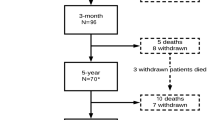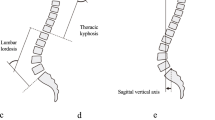Abstract
This study was designed to develop predictive models for surgical outcome based on information available prior to lumbar stenosis surgery. Forty patients underwent decompressive laminarthrectomy. Preop and 1-year postop evaluation included Waddell’s nonorganic signs, CT scan, Waddell disability index, Oswestry low back pain disability questionnaire, low back outcome score (LBOS), visual analog scale (VAS) for pain intensity, and trunk strength testing. Statistical comparisons of data used adjusted error rates within families of predictors. Mathematical models were developed to predict outcome success using stepwise logistic regression and decision-tree methodologies (chi-squared automatic interaction detection, or CHAID). Successful outcome was defined as improvement in at least three of four criteria: VAS, LBOS, and reductions in claudication and leg pain. Exact logistic regression analysis resulted in a three-predictor model. This model was more accurate in predicting unsuccessful outcome (negative predictive value 75.0%) than in successful outcome (positive predictive value 69.6%). A CHAID model correctly classified 90.1% of successful outcomes (positive predictive value 85.7%, negative predictive value 100%). The use of conservative surgical decompression for lumbar stenosis can be recommended, as it demonstrated a success rate similar to that of more invasive techniques. Given its physiologic and biomechanical advantages, it can be recommended as the surgical method of choice in this indication. Underlying subclinical vascular factors may be involved in the complaints of spinal stenosis patients. Those factors should be investigated more thoroughly, as they may account for some of the failures of surgical relief. The CHAID decision tree appears to be a novel and useful tool for predicting the results of spinal stenosis surgery

Similar content being viewed by others
References
Airaksinen O, Herno A, Turunen V et al (1997) Surgical outcome of 438 patients treated surgically for lumbar spinal stenosis. Spine 22:2278–2282
Aryanpur J, Ducker T (1990) Multilevel lumbar laminotomies: an alternative to laminectomy in the treatment of lumbar stenosis. Neurosurgery 26:429–432
Benz RJ, Garfin SR (2001) Current techniques of decompression of the lumbar spine. Clin Orthop 384:75–81
Caspar W, Papavero L, Sayler MK et al (1994) Precise and limited decompression for lumbar spinal stenosis. Acta Neurochir 131:130–136
Ciol MA, Deyo RA, Howell E et al (1996) An assessment of surgery for spinal stenosis: time trends, geographic variations, complications and re-operations. J Am Geriatr Soc 44:285–290
Crock HV, Crock MC (2000) Decompression of the sublaminar central canal, bilateral foramina, and nerve root canals. In: Gunzburg R, Szpalski M (eds) Lumbar spinal stenosis. Lippincott Williams and Wilkins, Philadelphia, pp 199–206
Epstein NE (1998) Decompression in the surgical management of degenerative spondylolisthesis: advantages of a conservative approach in 290 patients. J Spinal Disord 11:116–122
Fairbank JCT, Couper J, Davies JB et al (1980) The Oswestry low back pain disability questionnaire. Physiotherapy 66:271–227
Fraser RD, Hall DJ (1992) Laminectomy combined with posterolateral stabilisation: a muscle-splitting approach to the lumbosacral spine. Eur Spine J 1:249–253
Greenough CG, Fraser RD (1992) Assessment of outcome in patients with low-back pain. Spine 17:36–41
Gunzburg R, Szpalski M, Hayez J-P (1996) The surgical approach to the lumbar spine. In: Szpalski M, Gunzburg R, Spengler D, Nachemson A (eds) Instrumented fusion of the lumbar spine: state of the art, questions and controversies. Lippincott-Raven, Philadelphia, pp 17–24
Gunzburg R, Keller TS, Szpalski M et al (2003) Clinical and psychofunctional measures of conservative decompression surgery for lumbar spinal stenosis: a prospective cohort study. Eur Spine J 12:197–204
Gunzburg R, Keller TS, Szpalski M et al (2003) A prospective study on CT scan outcomes after conservative decompression surgery for lumbar spinal stenosis. J Spinal Disord (in press)
Javid MJ, Hadar EJ (1998) Long-term follow-up review of patients who underwent laminectomy for lumbar stenosis: a prospective study. J Neurosurg 89:1–7
Kass GV (1980) An exploratory technique for investigating large quantities of categorical data. Applied Statistics 29:119–127
Katz JN, Lipson SJ, Larson MG et al 1991) The outcome of decompressive laminectomy for degenerative lumbar stenosis. J Bone Joint Surg Am 73:809–816
Kauppila LI, Polak JF, Cupples LA et al (1997) New indices to classify location, severity and progression of calcific lesions in the abdominal aorta: a 25-year follow-up study. Atherosclerosis 132:245–250
Kaupilla LI, McAllindon T, Evans S et al (1997) Disc degeneration (back pain) and calcification of the abdominal aorta—a 25-year follow-up study. Spine 22:1642–1647
Keller T, Gunzburg R, Szpalski M, Spratt K (2003) Assessment of trunk function in single and multilevel spinal stenosis: a prospective clinical trial. Clin Biomech 18:173–181
Kleeman TJ, Hiscoe AC, Berg EE (2000) Patient outcomes after minimally destabilising lumbar stenosis decompression. Spine 25:865–870
Lin PM (1982) Internal decompression for multiple levels of lumbar spinal stenosis: a technical note. Neurosurgery 11:546–549
Main C (1983) The modified somatic perception questionnaire (MSPQ). J Psychosom Res 27:503–514
Munting E, Druez V, Tsoukas D (2000) Surgical decompression of lumbar spinal stenosis according to Senegas technique. In: Gunzburg R, Szpalski M (eds) Lumbar spinal stenosis. Lippincott Williams and Wilkins, Philadelphia, pp 207–214
Postacchini F (1996) Management of lumbar spinal stenosis. J Bone Joint Surg Br 78:154–164
Szpalski M, Hayez JP (1994) Objective functional assessment of the efficacy of tenoxicam in the treatment of acute low back pain. A double blind placebo controlled study. Br J Rheumatol 33: 74–78
Szpalski M, Gunzburg R (1998) Methods of trunk testing. Semin Spine Surg 10:104–111
Szpalski M, Federspiel CF, Poty S et al (1992) Reproducibility of trunk isoinertial dynamic performance in low back pain patients. J Spinal Disord 5:78–85
Tsai RY, Yaang R-S, Bray RS (1998) Microscopic laminotomies for degenerative lumbar spinal stenosis. J Spinal Disord 11:389–394
Turner JA, Ersek M, Herron L, Deyo R (1992) Surgery for lumbar stenosis: attempted meta-analysis of the literature. Spine 17:1–8
Verbiest H (1954) Radicular syndrome from developmental narrowing of the lumbar vertebral canal. J Bone Joint Surg Br 26:230–237
Waddell G, Main CJ (1984) Assessment of severity in low-back disorders. Spine 9:204–208
Waddell G, McCulloch JA, Kummel E et al (1980) Nonorganic physical signs in low-back pain. Spine 5:117–125
Weiner BK, Fraser RD, Peterson M (1999) Spinous process osteotomies to facilitate lumbar decompressive surgery. Spine 24:62–66
Acknowledgement
The authors would like to thank the International Society for the Study of the Lumbar Spine (ISSLS) for their support of this work with the MacNab/Larocca Research Fellowship Award.
Author information
Authors and Affiliations
Corresponding author
Rights and permissions
About this article
Cite this article
Spratt, K.F., Keller, T.S., Szpalski, M. et al. A predictive model for outcome after conservative decompression surgery for lumbar spinal stenosis. Eur Spine J 13, 14–21 (2004). https://doi.org/10.1007/s00586-003-0583-2
Received:
Revised:
Accepted:
Published:
Issue Date:
DOI: https://doi.org/10.1007/s00586-003-0583-2




